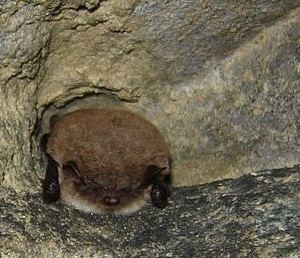
I’d never heard of a hibernoma until I came across this specimen in our collection. The distinct dark tan nodule at top is a phaeochromocytoma, but the flabby grey lobulated mass that makes up the bulk of the specimen is a hibernoma.
And yes, hibernoma derives from hibernation.
A hibernoma is a benign tumour composed of the same heat-generating fat or brown adipose tissue (BAT) found abundantly in hibernating mammals. Since we are mammals, it’s not too surprising that humans have (BAT). It’s well known that BAT is important in newborns (who are very susceptible to cold), but at one time it was thought that BAT disappeared by adulthood. But brown fat depots in adults can be visualised on positron emission tomography (PET) scans in the same areas as it occurs in neonates, and especially if the person was in a chilly environment when the scan was done!

![Sites of brown adipose tissue in adult humans, as revealed by PET scanning. [Image credit: Professor Jan Nedergaard, The Wenner-Gren Institute,The Arrhenius Labs, Stockholm University]](http://digipathblog.files.wordpress.com/2013/06/brown-fat-distribution-nedergaard-e1370609910305.jpg?w=300)
BAT appears brown due to the iron content of its many mitochondria. At a microscopic level brown fat differs from white fat in appearance, and unlike white fat has a rich vascular and nerve supply. Brown and white fat have a different histogenesis or cellular origin (see the origins of BAT). The latest finding is that adults have classical or constitutive BAT as well as an inducible “brite” (brown in white) form of BAT interspersed in ordinary white fat.

This is all very interesting, but currently the real excitement is around BAT being potentially manipulable for the control of diabetes, obesity and the metabolic syndrome. Weight loss is a prominent symptom in patients with phaeochromocytoma, and the stimulation of BAT may account for a good deal of it. BAT consumes more glucose than any other tissue and even small amounts substantially raise the metabolic rate. BAT can be switched off by a beta-adrenergic blocker (the sort commonly used to lower blood pressure).
I’ve studiously avoided the biochemistry of thermogenesis in BAT, which underlies this whole discussion, but it hinges on the unique uncoupling protein 1 (UCP1), also known as thermogenin, which operates in BAT mitochondria to divert the production of cellular energy (ATP) into the release of heat. Being able to switch on BAT is an enticing idea, and activating UCP1 is probably the key to such a designer drug.
References / readings
Nedergaard J, Bengtsson T, Cannon B. Unexpected evidence for active brown adipose tissue in adult humans. Am J Physiol Endocrinol Metab 2007; 293(2):E444-52
Osborne AB, Johnson MH. Hibernoma, a special fatty tumor; report of a case. Am J Pathol 1949; 25(3):467-79
Nedergaard J, Cannon B. The changed metabolic world with human brown adipose tissue: therapeutic visions. Cell Metab 2010; 11(4):268-72
Lean ME, James WP, Jennings G, Trayhurn P. Brown adipose tissue in patients with phaeochromocytoma. Int J Obes 1986; 10(3):219-27.
English JT, Patel SK, Flanagan MJ. Association of pheochromocytomas with brown fat tumors. Radiology 1973; 107:2 279-281.
Vijgen GH, Bouvy ND, Smidt M et al. Hibernoma with metabolic impact? BMJ Case Reports 2012 Aug 21.
